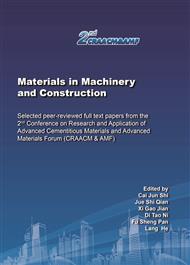[1]
T. Zhao. Concrete Permeability, Science Press Ltd., Beijing, (2006).
Google Scholar
[2]
J.M. Loche, A.Ammar, P. Dumargue, Influence of the migration of chloride ions on the electrochemical impedance spectroscopy of mortar paste, Cement. Concrete Res. 35 (2004) 1797-1803.
DOI: 10.1016/j.cemconres.2004.07.040
Google Scholar
[3]
G.E. Monfore, The electrical resistivity of concrete, J. PCA. Res. Dev. Lab. 5 (1968) 35-48.
Google Scholar
[4]
M.R. Hansen, M.L. Leming, P. Zia, et al, Chloride permeability and AC impedance of high performance concrete, ACI. SP. 140 (1993) 121-146.
Google Scholar
[5]
R.F. Feldman, G.W. Chan, R.J. Brousseau, et al, Investigation of the rapid chloride permeability test, Mater. J. 91 (1994) 246-255.
Google Scholar
[6]
X. Lu, M. Chen, F. Yuan, et al, Evaluation of concrete permeability by critical voltage, Cement. Concrete Res. 30 (2000) 973-975.
DOI: 10.1016/s0008-8846(00)00267-2
Google Scholar
[7]
J. Han, K. Li, Adaptability of the evaluation methods of concrete anti-chloride penetration ability, J. Building Mater. 18 (2015) 704-709, 715.
Google Scholar
[8]
M. Maes, E. Gruyaert, N. Belie, Resistance of concrete with blast-furnace slag against chlorides, investigated by comparing chloride profiles after migration and diffusion, Mater. Stru. 46 (2013) 89-103.
DOI: 10.1617/s11527-012-9885-3
Google Scholar
[9]
Z. He, C. Shi, X. Hu, et al, Development on migration characteristic and interactions of chloride ion in cement-based materials under applied voltages, J. Chin. Cer. Soc. 43 (2015) 1111-1119.
Google Scholar
[10]
X. Hu, C. Shi, Z. Shi, et al, Compressive strength, pore structure and chloride transport properties of alkali-activated slag/fly ash mortars, Cement. Concrete Comp. 104 (2019) 103336.
DOI: 10.1016/j.cemconcomp.2019.103392
Google Scholar
[11]
S. Kumar, R. Kumar, S.P. Mehrotra, Influence of granulated blast furnace slag on the reaction, structure and properties of fly ash based geopolymer, J. Mater. Sci. 45 (2010) 607-615.
DOI: 10.1007/s10853-009-3934-5
Google Scholar
[12]
Y. Bai, Investigation of mechanical performance and relationship between mechanical and microstructure characterization of alkali-activated slag, Qing. Uni. Tech. (2016).
Google Scholar
[13]
G. Liu, Study on mechanism of binding chloride ion in alkali-activated slag, Qing. Uni. Tech. (2018).
Google Scholar
[14]
M.A. Cincotto, A.A. Melo, W.L. Repette, Effect of different activators type and dosages and relation to autogenous shrinkage of activated blast furnace slag cement, ICC. S. Afr. (2003) 1878-1897.
DOI: 10.1016/j.cemconcomp.2010.01.004
Google Scholar
[15]
Y. Zhang, The mechanical properties and transport properties under loading of alkali-activated slag concrete, Qing. Uni. Tech. (2017).
Google Scholar
[16]
C. Shi, Alkali-activated cements and concretes, Chem. Ind. Press Ltd., Beijing, (2008).
Google Scholar
[17]
C. Yang, S. Weng, Effect of 95 °C temperature on the chloride-migration of concrete using electrical field, Mater. Chem. Phys. 125 (2011) 876-882.
DOI: 10.1016/j.matchemphys.2010.09.026
Google Scholar


